UC Blogs
A Luncheon in the Garden
(Editor's note: This event has been postponed until the fall of 2013. Details pending.) Mark your calenders! The Honey and Pollination Center at...
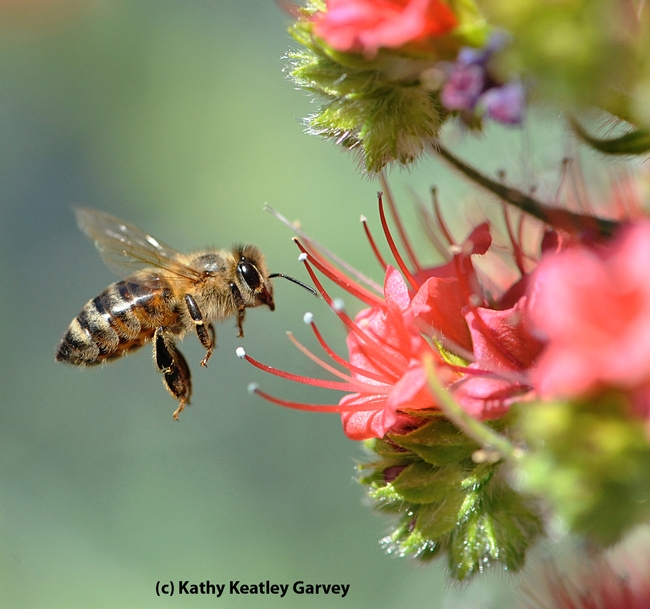
Honey bee heading toward tower of jewels, Echium wildpretii. (Photo by Kathy Keatley Garvey)
Succulents are Super!
Last month, the San Francisco Flower and Garden Show delivered its usual spring dose of inspiration. One of the most jaw-dropping exhibits was a huge rotating globe totally covered in succulents. The succulents were grouped in such a way that the different colors represented the continents and oceans. It was magnificent.
I also had the opportunity to attend a lecture on succulent maintenance by Robin Stockwell from Succulent Gardens in Castroville. It turns out, they were the team behind the globe. The finished globe weighs over a ton. The team started planting in late August-early September for the late March show. The globe has about 30,000 cuttings. Someone from his team has sent in paperwork to the Guinness Records organization to see if it might be the largest succulent planting in history.
Aside from the interesting background of the construction of the globe exhibit, Mr. Stockwell gave us many succulent pointers. He suggested a mixture of one part perlite to four parts regular potting mix for a custom succulent potting mixture. He fertilizes with half strength of a balanced fertilizer (he stated it didn't really matter what kind) once a month.
His pruning demonstration led to audible gasps from the crowd as he cut off a lovely Aeonium rosette. He explained that the larger the stem, the longer it would take for the cut to scab over and be ready for planting. He estimated that the piece he had cut would take two weeks before it would be ready to plant. He also suggested cutting the resultant tall stem left on the remaining plant down further so that branching would occur lower down. This cut he advised making at an angle so that water would not accumulate in the cut and lead to rot.
For those of you who didn't make it to the show, Mr. Stockwell mentioned that they are looking into taking the globe on tour. (The logistics of that make my brain spin) Hopefully, in the meantime, the photos will help. I must say though that photos don't do it justice.
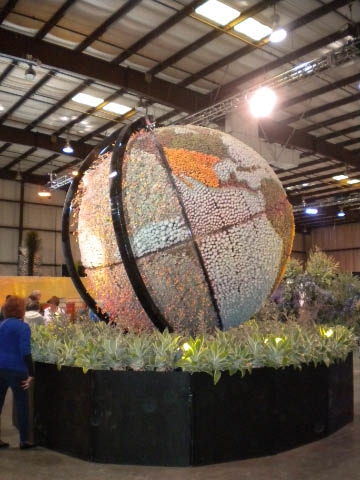
Succulent globe. Photos by Karen Metz
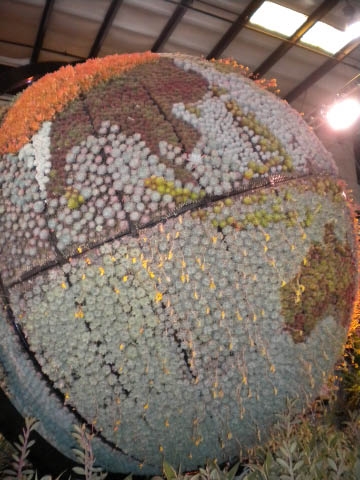
succulent globe 2
Sorry Ladies!
Back in February, I wrote a blog that was a bit of a love letter to our three hens. Today we planted our tomatoes, so the love story has, sadly, come to a screeching halt.
This year’s tomatoes went into one of two raised beds, which have sat fallow for two years. I have always had to create a “dome of protection” with bird netting over the raised beds, as they abut a large open space where coveys of hungry quail lurk. And now we have to worry about our hens raiding the garden boxes, too.
Bird netting is hateful stuff. It catches on everything — branches, leaves, earrings, eyelashes. We wanted to make our lives easier, when it comes to bird netting, by building semi-permanent frames onto which we could wrap netting. I found a thorough online description for building PVC frames, and the construction began.
Our two raised beds are 4 feet by 10 feet. We started out making one rectangular frame to fit over the top of the beds. This was unwieldy to build, and would be too heavy and wobbly to move out of the way for harvesting and such. My husband decided to construct two frames, 4 feet by 5 feet each, and they went together much more easily. The beauty of two frames is they’re light. I can raise one half of the cover to harvest, add mulch or pull weeds. Knowing how tall indeterminate tomatoes can become, we plan to make two more frames that will stand taller. For now, the 3-foot height is fine.
Our hens are a bit miffed. They saw us put in the tomato seedlings this morning, and rushed over to gobble up those sweet new leaves. After much shooing and distracting with fresh, wormy piles of compost thrown their way, my husband and I were able to cover our new plants with our new frames. I’ll keep you posted on how well they work.
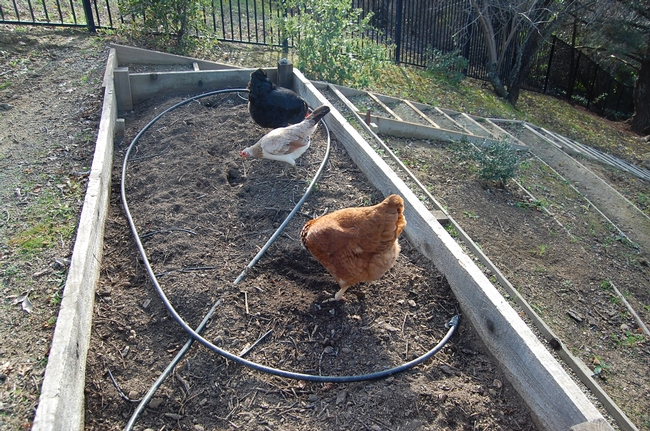
In February, our three hens were welcome to forage in the fallow raised beds. photos by Kathy Thomas-Rico
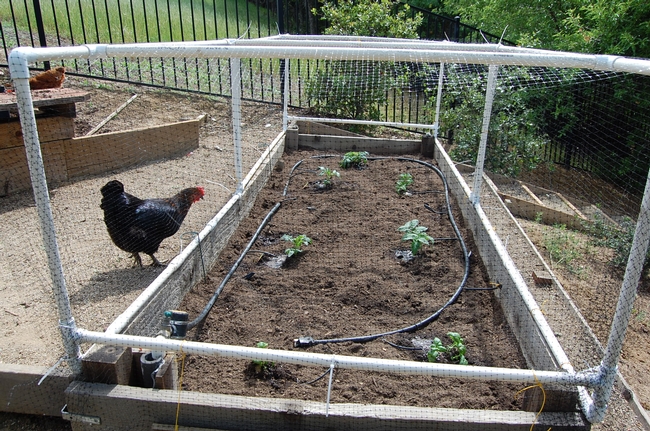
The newly planted bed, with new bird-netting frames, is no longer as welcoming to the hens and local quail.
Plant Chewing Puppy
It is about time to make some choices for my spring vegetable garden. Tomatoes come to mind first. Last year my tomatoes did well and I have been looking forward to trying a few newcomers this year. But, as I now have a puppy in the house, I thought “are tomatoes toxic to my new pup, Marco ?”. This little guy hasn’t met a plant that he doesn’t want to chew. Soon after he entered our home, he made it clear that I needed to be aware of the hazards living in the backyard. He would come in from a romp in the yard with a mouthful of flower petals or twigs he pulled from a tree or bush.
I talked to my vet about Marco and his attraction to plants. He handed over a stack of literature. Among them was a pamphlet published by the ASPCA with lists of foods and plants that can be harmful to our pets. This pamphlet was the beginning of my quest for more information on toxic plants. I found a number of websites including www.petpoisonhelpline.com and www.ASPCA.org/pet-care/poison-control that were very informative and helpful as I inventoried the plants in my backyard, then researched each one for toxicity information. These sites also provided details on the mechanisms of toxicity. You would think that I would have known better. But no, I was shocked to find that a good number of plants in my yard were indeed toxic to my new housemate.Well, I now have some happy neighbors with many plants in the Liliaceae family, my Hydrangeas, many Euphorbias, and Nandina domestica ‘Compacta’now planted in their yards. I expect as Marco grows out of his puppy-hood, he will be less attracted to the plants for chew toys. But who knows, and in the meantime I have peace of mind that he won’t get sick from these plants. Even though, these websites and reference manuals have multiple tables and lists galore, of toxic plants. There are so many plants coming into the nurseries . At this point if I can’t find information on a plant, I assume it could be toxic and won’t purchase it.
So now, back to the tomatoes and other vegetable potentials for my spring garden. This time I started with the handbook provided during my Master Gardener training back in 2009, The California Master Gardener Handbook, a University of California, Agriculture and Natural Resource publication. And yep, right there on page 643 is a table of Vegetables that Contain Natural Toxins. And yes, tomatoes are on the toxic list. In the case of Solanum lycopersicum, aka tomatoes, The toxic parts of the tomato are the leaves, stems and green tomatoes . So know I go to the www.petpoisonhelpline.com to get the scoop on tomatoes. This site provides the following: The tomato is poisonous to cats, dogs and cows. Common signs to watch for are vomiting, diarrhea, lethargy, weakness and confusion. The ripened fruit of the tomato plant is considered non-toxic but the green parts of the plant contain solanine, a glycoalkoloid. Solanine is also found in many other plants in the Solanaceae family including the potato plant (green parts only). Typically, when ingested by dogs and cats it rarely results in toxicity. A large amount needs to be ingested (e.g.typically in cattle) for solanine to result in severe poisoning. . As I read it, the plants probably won’t kill my pup, just make him sick. So for this spring I think I will skip the tomatoes and go to Larry Produce for my annual tomato canning frenzy.
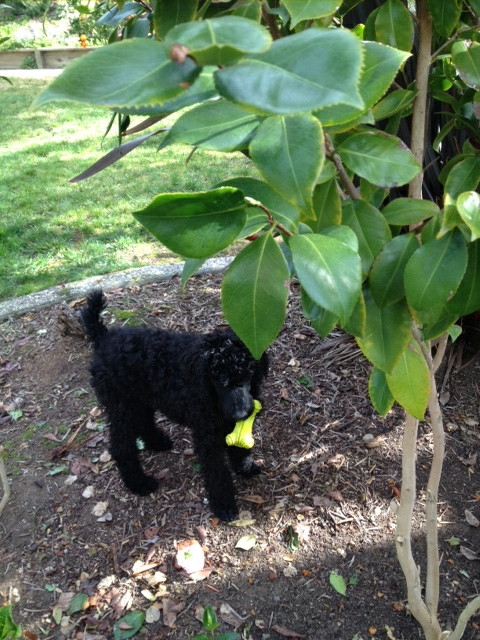
Marco, plant-eating puppy. photo by Trisha Rose
Toward Sustainable Bioenergy Landscapes
His talk should draw a good crowd. Claudio Gratton, associate professor in the Department of Entomology, University of Wisconsin, will speak on...
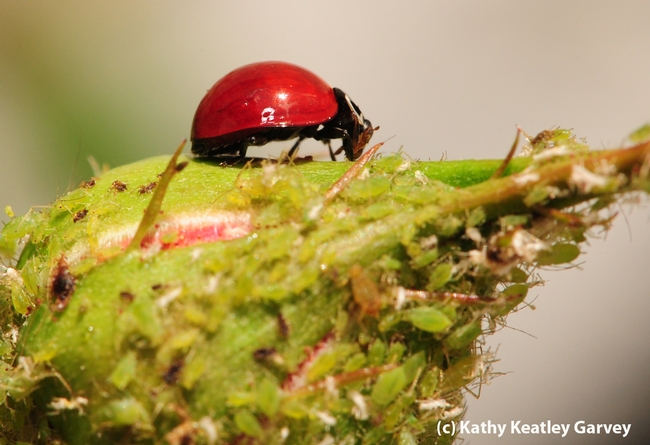
How do beneficial insects such as lady beetles utilize the landscape? Claudio Gratton will explain how in his April 10 lecture. (Photo by Kathy Keatley Garvey)

